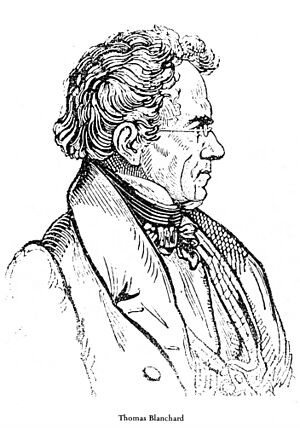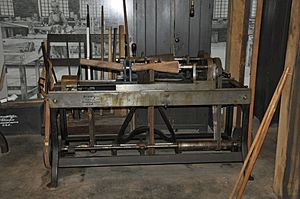Thomas Blanchard (inventor) facts for kids
Quick facts for kids
Thomas Blanchard
|
|
|---|---|

Thomas Blanchard
|
|
| Born | June 24, 1788 |
| Died | April 16, 1864 (aged 75) |
| Nationality | American |
| Occupation | inventor |
Thomas Blanchard (born June 24, 1788 – died April 16, 1864) was an amazing American inventor. He spent a lot of his life in Springfield, Massachusetts. In 1819, he helped start the idea of the assembly line in America. This is a way to make many things quickly. He also invented the first special machine called a lathe that could make parts that were exactly the same, which are called interchangeable parts.
Blanchard worked for many years with the Springfield Armory, which made weapons. In 1825, he even invented what some call America's first car! He called it a "horseless carriage," and it ran on steam. During his life, Thomas Blanchard received more than twenty-five patents for all his cool inventions.
Contents
Thomas Blanchard's Early Life and Inventions
Making Tacks Faster
Thomas Blanchard was born in a town called Sutton, Massachusetts. He loved working with machines from a young age. He used to help his brother make small nails called tacks by hand. This was a very slow and tiring job.
So, in 1806, Thomas invented his first machine. It was a mechanical tack-maker! This machine could make five hundred tacks every minute. Plus, the tacks it made were much better than the ones made by hand. He later sold the rights to his machine for $5,000, which was a lot of money back then!
Machines for Making Guns and Copies

After his tack machine, Blanchard started thinking about how to make gun barrels. He invented a special machine tool that made the process of creating gun barrels much easier and faster. The Springfield Armory hired him, and he finished this machine in 1822.
This machine could shape and finish gun barrels all in one step. It could even make the octagon (eight-sided) part of the barrel by changing how the lathe moved. This invention was later used to shape all sorts of uneven objects.
He also created a special machine called a copying lathe in 1818. This machine could trace a model and then automatically make a perfect copy. It was first used to make gun stocks (the wooden part of a gun). Later, in the 1850s, this copying lathe was used to make shoe lasts. Shoe lasts are the forms that shoes are shaped around. Because the machine could make exact copies of lasts, it became possible to make shoes in standard sizes for everyone.
Steam-Powered Travel and Other Inventions
Thomas Blanchard also thought about how people could travel better. Before railroads became common in the United States, he invented a "steam wagon." This was like an early car that ran on steam.
In 1831, he also created a powerful steamboat that could travel upriver. This boat was used on the Connecticut River and in the West. He invented and patented both of these in Springfield, Massachusetts. In 1851, he designed a machine that could bend very thick and strong wood.
Blanchard also built machines that could cut and fold envelopes in one go. He also made several machines for mortising, which is a way of cutting holes or slots in wood to join pieces together.
Blanchard's Patents
Thomas Blanchard received many patents for his inventions. Here are a few examples:
- X0002080 Horizontal shearing machine (May 4, 1813)
- X0003010 Machine for tacks and brads (October 3, 1817)
- X0003131 Turning irregular forms (September 6, 1819)
- X0003436 Machine for turning gun stocks (September 6, 1819)
- X0004832 Regulating the speed of carriages (December 28, 1825)
- U.S. Patent 3 Machine for turning wooden parts for ships' pulleys (August 1, 1836)
- U.S. Patent 5 Machine for cutting holes in ships' pulleys (August 10, 1836)


